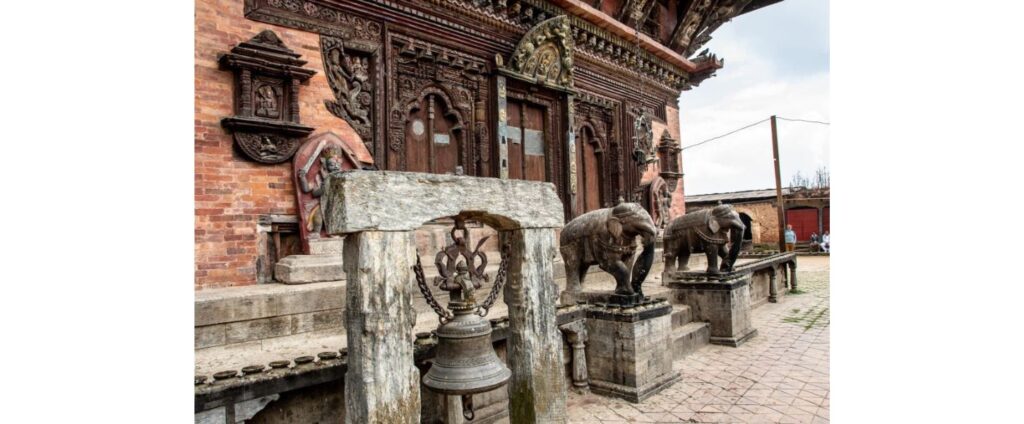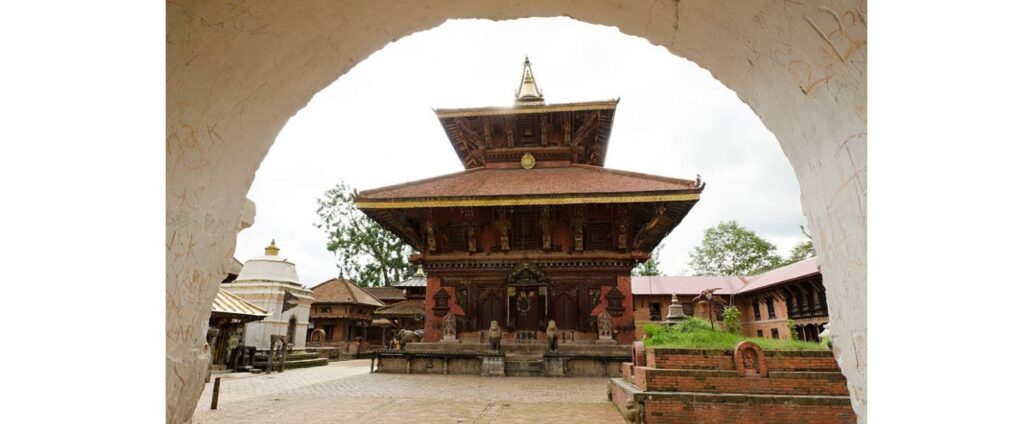Changu Narayan Temple: UNESCO World Heritage Site

The Changu Narayan Temple, one of the oldest temples, is almost 3000 years old and is thought to have been constructed in the Lichhavi Era, around the fourth century. The temple, located on a hilltop 4 kilometers north of Bhaktapur, used to be surrounded by a dense champak tree forest and the small community of Changu.
The Manohara river flows alongside the hill, located 12 kilometers east of the capital. The main shrine was built around 325 AD, and the temple was rebuilt in 1702 AD after a terrible fire.
An ancient Hindu temple named Changu Narayan is found in Nepal’s Changunarayan Municipality in the Bhaktapur District atop a tall hilltop, also known as Changu or Dolagiri. This hill is located a few miles north of Bhaktapur and roughly 7 miles (or 12 km) east of Kathmandu. The Hindu population holds great reverence for the Lord Vishnu-dedicated shrine.
According to legend, a monarch of Kashmir offered his daughter Champak to the prince of Bhaktapur for marriage. She is thought to have inspired the name of the temple. Apart from the main temple, several additional shrines are on the property dedicated to Gods and Goddesses such as Chinna Masta, Lord Ganesh, and Lord Krishna.
The temple is devoted to the Hindu deity Lord Vishnu. One of the earliest stone slabs, which belongs to the fifth century and has several inscriptions from the Lichhavi Era, is also found on the grounds of Changu Narayan.
Architecture of Changu Narayan Temple
The Changu Narayan Temple is situated above hills and is encircled by a Champak tree forest. In and near Changu Narayan are residents of the Brahman, Chhetri, Tamang, Newar, and other communities. With the growth of tourism in this area, there are numerous small and medium-sized hotels, restaurants, gift shops, etc. On the route to Changunaran, there is an old stone tap that is thought to have been there since the time of Lichhavi.
As far as temples go, Changu Narayan is the oldest in Nepal. Rich embossing artistry makes it a landmark in Nepali temple construction. The temple has a two-story roof supported by a tall stone plinth. Professor Madhan Rimal of the Sociology and Anthropology Department of Tribhuvan University claims that the temple is neither built in the Shikhara architecture nor the pagoda style. In terms of architectural design, he would characterize it as a traditional Nepali temple. At Gokarna Mahadev, you may find a lot of similar qualities. Lord Vishnu-themed statues and works of art surround the shrine.
In the main temple’s courtyard, we may also discover temples dedicated to Lord Shiva, Ashta Matrika, Chhinnamasta, Kileshwor, and Krishna. The temple features four doors, and on either side of each entrance are life-size pairs of various animals, including lions, sarabhas, griffins, and elephants. The struts that support the roof are decorated with carvings of Lord Vishnu’s eleven incarnations and other idols.
Naga carvings are gilded on the entrance door (snakes). At the top of a stone pillar on the main entry gate (i.e., the western entrance gate), we can see the Chakra, Sankha, Kamal, and Khadga. A Sanskrit inscription can be found on these stone pillars.
The stone inscription pillar was built in 464 AD by Licchavi (kingdom) King Manadeva and is regarded as the oldest inscription in Nepal.
History Behind Changu Narayan Temple
In the past, a Gwala, or cow herder, acquired a cow from Sudarshan, a Brahmin. The cow had a reputation for producing a lot of milk. Previously, the cow was taken to Changu by the cow herder for grazing. Changu was then covered with a grove of Champak trees.
A boy used to visit the cow while it was grazing in the shade of a particular tree and sip the animal’s milk. When the cow herder started milking her in the evening and took her home, he only received a minimal amount of milk. This went on for a few days.
He became very discouraged and contacted the Brahmin, complaining that the cow wasn’t giving enough milk. Sudarshan concurred with the cow herder after seeing this with his own eyes. The cow was grazing in the forest the following day, and they watched her during the day.
Both the cow herder and the Brahmin crouched behind the tree. They were shocked when a young black boy emerged from the tree and began guzzling the cow’s milk. The youngster must be the devil, and the tree must be its residence, thought the two indignant men.
So the Champak tree was cut down by the Brahmin. His actions caused fresh human blood to spill out of the tree. Brahmin and the cow herder started to sob as they became terrified that they had done a serious offense. The Brahmin and Cowherd were told by Lord Vishnu, who had just emerged from the tree, that it was not their fault.
Vishnu narrated how, while out hunting in the forest, he had unintentionally killed Sudarshan’s father, committing a heinous crime. After that, cursed for the crime, he rode his mount, “Garuda,” around the globe before coming to rest on the hill at Changu. He lived there by stealing milk from cows and living in anonymity.
Vishnu was beheaded by a Brahmin when the tree was cut down, atoning for his crimes. After hearing these remarks from Lord Vishnu, a cow herder and a Brahmin decided to worship the location and built a tiny shrine in his honor. The location has been revered ever since. Even today, we still see the cow herder’s descendants as Ghutiyars and Sudarshan’s descendants serving as temple priests.
You may also like: Bhaktapur Durbar Square: UNESCO World Heritage Site
Monuments in Changu Narayan Temple
Mandeva built a historical pillar in 464 AD.
Garuda: Lord Vishnu’s flying chariot, Garuda, has a human face and is devoted to Vishnu.
Chanda Narayan: A stone sculpture of Vishnu astride a Garuda from the seventh century is called Chanda Narayan (Garuda Narayan). The Nepal Rastra Bank’s 10-rupee paper note features a picture of this sculpture.
Vishnu, Laxmi, and Garuda are depicted on the stone sculpture Sridhar Vishnu, dating to the ninth century.
Vaikuntha Vishnu: It is a sculpture from the 16th century that depicts Vishnu reclining in the Lalitasan position on a six-armed Garuda with Laxmi seated on his lap.
Chhinnamasta: This temple is devoted to Chhinnamasta Devi, who sacrificed her life by beheading herself and giving her blood to feed Dakini and Varnini.
Kileshwor: A pair of little Lord Shiva temples with two stories, thought to have appeared here to guard the hill.
Hindus and Buddhists revere the shrine’s central image as Garuda Narayan and Hariharihari Vahan Lokeshwara, respectively. The priest can only see the image.
Vishworup: The moment from the Bhagwat Gita in which Lord Krishna unveils his universal form to his follower Arjun is depicted in the exquisitely carved stone sculpture known as Vishworup from the seventh century.
Vishnu Vikrant: It is a sculpture of Trivikram Vishnu from the seventh century that portrays the scene from the well-known Hindu narrative between Lord Vishnu and his beloved Bali Raja.
Narasimha: A sculpture of Narasimha, a manifestation of Lord Vishnu, from the seventh century depicts him slaying the demon King Hiranyakasyapa to save his devotee Prahalad.
Kileshwor: A pair of little Lord Shiva temples with two stories, thought to have appeared here to guard the hill.
Hindus and Buddhists revere the shrine’s central image as Garuda Narayan and Hariharihari Vahan Lokeshwara, respectively. The priest can only see the image. After entering the courtyard through the temple’s main entrance (the Eastern gate), you will find the following monument on the right side.
Conclusion
The temple is a superb example of Nepali architecture, with ornate embossed wood and metal sculptures. The temple is a two-story structure with a high stone plinth. According to research by Professor Madan Rimal of the department of Sociology and Anthropology, the temple’s architecture is traditional to Nepal. It is similar to that of the Gokarna Mahadev temple. It is neither in the Shikara style nor the Pagoda style.
The temple features four doors, and on each side of each entrance, a life-size pair of animals, such as a lion, sarabha, griffin, or elephant, stands to watch. The 10 forms of Lord Vishnu and other wooden icons can be seen on the temple’s struts.
The temple grounds are lighted during celebrations like the Changu Narayan Jatra, Mahashanan, Haribodhimi Ekadashi, and particularly Nag Panchami.
FAQs
1. Is Changu Narayan World Heritage Site?
A world heritage site is the Changu Narayan Temple. Archeological, historical, and cultural significance can be found in the priceless stone sculpture and antiquated inscriptions.
2. What is Changu Narayan temple famous?
A two-story Lord Vishnu temple in the pagoda style called Changu Narayan is surrounded by age-old carvings and statues. It is said to be the oldest Hindu temple still in use in the Kathmandu Valley till today.



